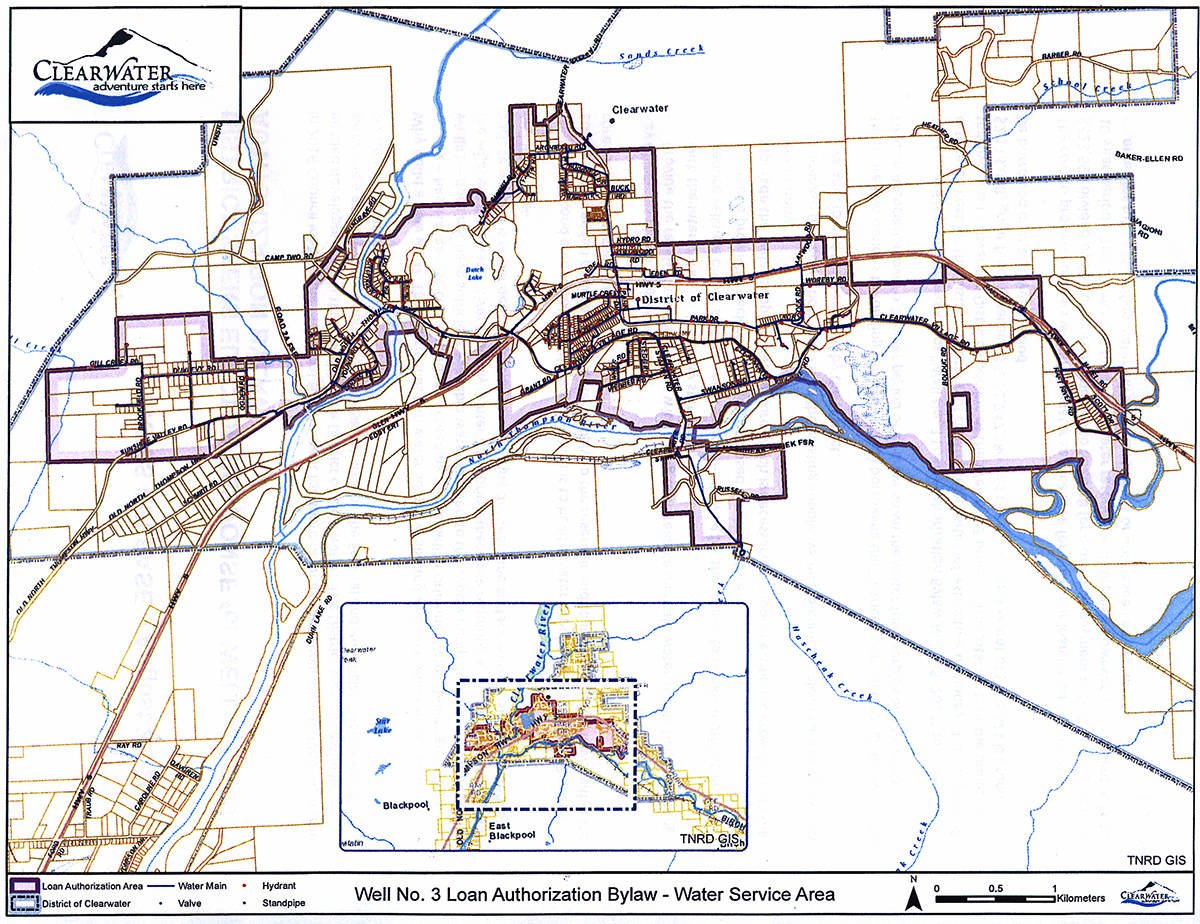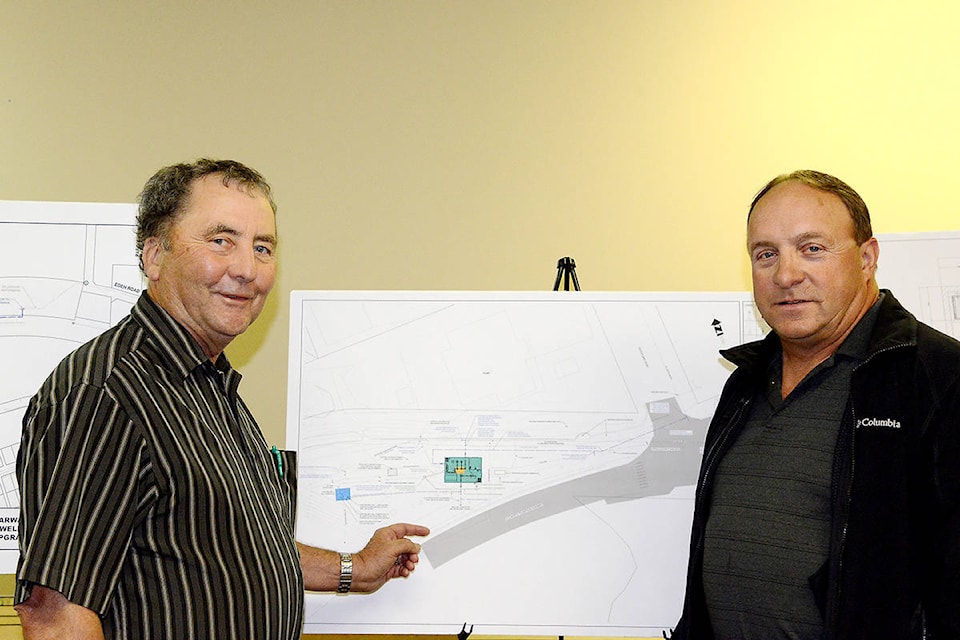By Keith McNeill
There were plenty of questions asked but not a lot of opposition voiced.
That seemed to be the outcome of an information meeting about District of Clearwater’s plans to borrow $315,000 to pay for a third well and upgrades to the community’s water system.
The meeting was held Wednesday evening, Sept. 13 in Dutch Lake Community Centre. About 21 people attended.
The District presently has two wells plus a gravity-fed system, said engineer Terry Underwood.
Each has its own strengths and weaknesses.
Well #1 is located in Reg Small Park next to the RCMP detachment.
Built in 1980, it has operated for 37 years without any major problems.
“It’s really very amazing,” Underwood said.
He noted that the well’s pump has been going 24 hours a day since the third week of June and has been supplying about 40 per cent of Clearwater’s water this summer.
It has good though not great capacity at 30 l/sec (470 gal/min).
Its principal shortcoming is that it is not as deep as originally planned, meaning its capacity goes down when the water in the adjacent Clearwater River goes down.
Well #2, which is located across from Dutch Lake beach, was drilled in 1999.
It has a much larger capacity, with flows of 70 l/sec (1,100 gal/min) but two main shortcomings.
The first is that the supply mains are too small to accommodate the flows that the well can produce – usually the pump is run at no more than 500 gal/min.
The second is that, starting in 2004, manganese began showing up in the well’s water.
Manganese combines with chlorine to produce a black sediment that is not a health issue but does affect aesthetics and such things as laundry.
As a result, the District has been using Well #2 as little as possible.
The gravity-fed system draws water from Russell, Hascheak and MacDougall creeks, which are located behind the ski hill.
This was Clearwater’s original water system, and was upgraded in 2013 with a UV treatment.
Its capacity is 40 l/sec (630 gal/min) but it is not reliable.
During the spring it is not used because of turbidity in the water.
It also cannot be used when the water level in the creeks is too low.
This summer, for example, it has not been used since Aug. 8.
The gravity-fed system also was not used during the late summers of 2003, 2006 and 2015.
When it is not being used the District’s only option is to use Well #2, with its manganese.
Its advantages are it produces great water and, being gravity-fed, there are no pumping costs.
Clearwater uses an unusual amount of water for its population, Underwood said.
“We’ve been trying to figure out where it’s going and fixing leaks,” he said.
Although the population has stayed about the same, water use went up 20 per cent over the three years prior to 2016, and then up another 10 per cent to 2017.
“Clearly we can’t keep building wells to meet excessive water demands,” the engineer said.
The third well is located in Reg Small Park next to Well #1 and is 16 inches in diameter.
It has already been drilled and tested. Sustained pumping at 1,000 gal/min only dropped the water level in the well four feet.
“It must be a really good aquifer,” Underwood commented.
The old pump-house is to be demolished and a new one constructed where the cenotaph is now (Clearwater-Vavenby Legion is fundraising to build a new memorial).
The new pump-house will be 13.2x9.1 m (42x32 ft) in size. It will be similar in appearance to the field-house at Rotary Sports Park, except there will be hatches in the roof so the pump and other machinery can be easily pulled out.
There will be a 50,000 gallon holding tank under the building to ensure the chlorine is in contact with the water for 15 to 20 minutes before it goes out into the system.
Having a higher capacity well does not make a lot of sense unless capacity of the water mains is also upgraded, he pointed out.
At present, water pumped from the two wells goes up Clearwater Village Road to near the Catholic Church and then through Weyerhaeuser subdivision to the reservoir near Archibald Road.
The proposed upgrade would see 800 m of mostly 12 inch new water main installed along the north side of Highway 5 to Eden Road.
The contract to install the new water main has already been awarded to On Call Services.
The pump-house contract will go to tender before the end of September.
Total cost of the project is put at $2.1 million. Of this, the federal and provincial governments are paying 83 per cent or $1.7 million, leaving District of Clearwater to pay $365,000.
Developer cost charges (fees charged to developers) will cover $50,000 of this, meaning the District still needs $315,000 for its share.
Only those opposed need vote
“This is something like the Geopark process except it’s nothing like the Geopark process,” said Leslie Groulx, District of Clearwater’s chief administrative officer.
She was referring to a recent attempt by Thompson-Nicola Regional District to get voter consent to fund an application for Geopark status for the North Thompson Valley through the alternative approval process.
Under the AAP, if more than 10 per cent of the electors in the service area register their opposition to the proposal, then it does not go ahead.
About 16 per cent of the electors in the Geopark service area voted against it, meaning it will not go ahead.
Groulx evidently hoped that there would not be similar opposition to the water tax proposal.
Town council decided to go ahead with the project even though it did not have approval to borrow because the 83 cent dollars are available from the provincial and federal governments for only a limited time, she said.
The District has about $400,000 in its water reserves – enough to cover the shortfall if the voters turn down the loan request, but would it would be better to keep those reserves in case there is an emergency, the CAO felt.
The loan authorization bylaw asks for permission to borrow over $700,000, not $315,000. That was a requirement from the provincial government, Groulx said, just in case the money from the grants does not come in on time.
The parcel tax will apply only to properties serviced by the District’s water system, including empty lots.
Those opposed to the loan bylaw have until 4 p.m. on Tuesday, Oct. 10 to submit their elector response forms to the District (not Oct. 9 as originally stated, as that is a holiday – Thanksgiving Day).

